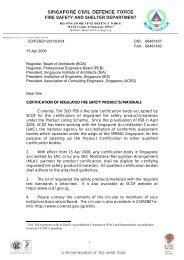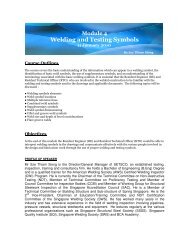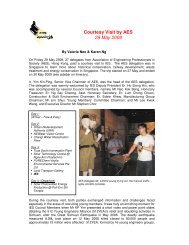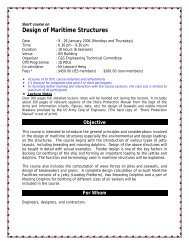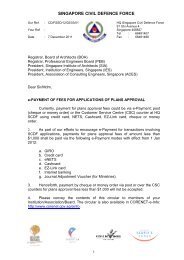civil & structural engineering - Institution of Engineers Singapore
civil & structural engineering - Institution of Engineers Singapore
civil & structural engineering - Institution of Engineers Singapore
Create successful ePaper yourself
Turn your PDF publications into a flip-book with our unique Google optimized e-Paper software.
PROJECT APPLICATION<br />
THE CANAL IN NUMBERS<br />
Inauguration <strong>of</strong> the canal: 15 August 1914.<br />
First <strong>of</strong>fi cial crossing: the Ancon ships, in 9 hours 40 minutes.<br />
Length <strong>of</strong> the canal: 80 km.<br />
Dimensions: maximum depth 12 m, variable width from<br />
240 m to 300 m in Lake Gatún, and 90 m to 150 m in<br />
correspondence with the so-called Culebra Cut.<br />
Canal operating mechanism: a system <strong>of</strong> locks divided into<br />
compartments, with entry and exit gates to lift the ships<br />
which then navigate to Lake Gatún to be lowered down<br />
to sea level.<br />
Dimensions <strong>of</strong> chambers in the locks: 33.53 m (width) and<br />
304.8 m (length).<br />
Number <strong>of</strong> workers employed during construction <strong>of</strong> the canal<br />
(from 1904 to 1913): 56,307, from every part <strong>of</strong> the world.<br />
Number <strong>of</strong> employees (as at September 2010): 9,759.<br />
Average time required to navigate the canal: 8 hours to 10<br />
hours, for average-sized ships.<br />
Number <strong>of</strong> ships navigating the canal, from 1914 to 2010:<br />
1,004,037.<br />
CONSTRUCTION CHALLENGES<br />
The key elements <strong>of</strong> this project are the two enormous locks,<br />
one on the Atlantic coast and the other on the Pacifi c coast.<br />
Work includes excavating and dredging the canal access on both<br />
sides for a total length <strong>of</strong> 11.2 km and a total width <strong>of</strong> 218 m.<br />
Each new lock facility will have three consecutive chambers (a<br />
lower, medium and upper chamber), regulated by four sliding<br />
gates which are designed to move the vessels from sea level<br />
to the level <strong>of</strong> Gatún Lake (26 m above sea level) and back<br />
down again.<br />
Each chamber will have three lateral water reutilisation basins<br />
for a total <strong>of</strong> nine basins per lock and 18 basins in total. Like<br />
in the existing locks, the new locks will be fi lled and emptied<br />
by gravity, without the use <strong>of</strong> pumps (200 million litres for<br />
each crossing).<br />
The new lock chambers will be 427 m long, 55 m wide and 18 m<br />
deep, and will have a total length <strong>of</strong> 1.5 km. The two enormous<br />
reinforced concrete structures will be completed with a new<br />
canal access on the Pacifi c side.<br />
Cimolai, from Pordenone, Northern Italy, will supply the new<br />
gates. Work will involve constructing 16 aluminium plate sliding<br />
gates, each one measuring 28 m in height, 58 m in length and<br />
16 m in width.<br />
The locks will be transported to Panama by sea and then<br />
installed on site between July 2013 and January 2014.<br />
A schematic layout <strong>of</strong> the canal, from the locks at Gatún to the locks at<br />
Mirafl ores.<br />
A BRIEF HISTORY OF THE CANAL<br />
The Panama Canal is one <strong>of</strong> the most important feats <strong>of</strong><br />
<strong>engineering</strong> in the world, and is a must-see for anyone<br />
visiting the city. It was dug out in one <strong>of</strong> the tightest<br />
points and in the lowest part <strong>of</strong> the Central Cordillera <strong>of</strong><br />
the isthmus which links the North American and South<br />
American continents. It takes a ship from 6 to 10 hours to<br />
navigate the canal which is made up <strong>of</strong> various elements<br />
- Gatún Lake, the Culebra Cut and the system <strong>of</strong> locks<br />
(Mirafl ores and Pedro Miguel on the Pacifi c Ocean side<br />
and Gatún on the Atlantic Ocean side). Gatún Lake,<br />
whose waters are fundamental for the functioning <strong>of</strong> the<br />
inter-oceanic waterway, was the largest artifi cial lake in the<br />
world for a number <strong>of</strong> decades. The system <strong>of</strong> locks allows<br />
ships to travel between the Atlantic and Pacifi c Oceans,<br />
without having to circumnavigate South America. The<br />
ships are raised and lowered 26 m (due to the change in<br />
water level) as they transit the canal. Constructed by the<br />
US, between 1904 and 1914, the Panama Canal is still a<br />
symbol <strong>of</strong> the strategic importance <strong>of</strong> the isthmus, which<br />
it has maintained since the 16 th century, and is one <strong>of</strong> the<br />
most important communication routes in the world.<br />
A comparison between the existing and new locks.<br />
February 2013 THE SINGAPORE ENGINEER<br />
35




